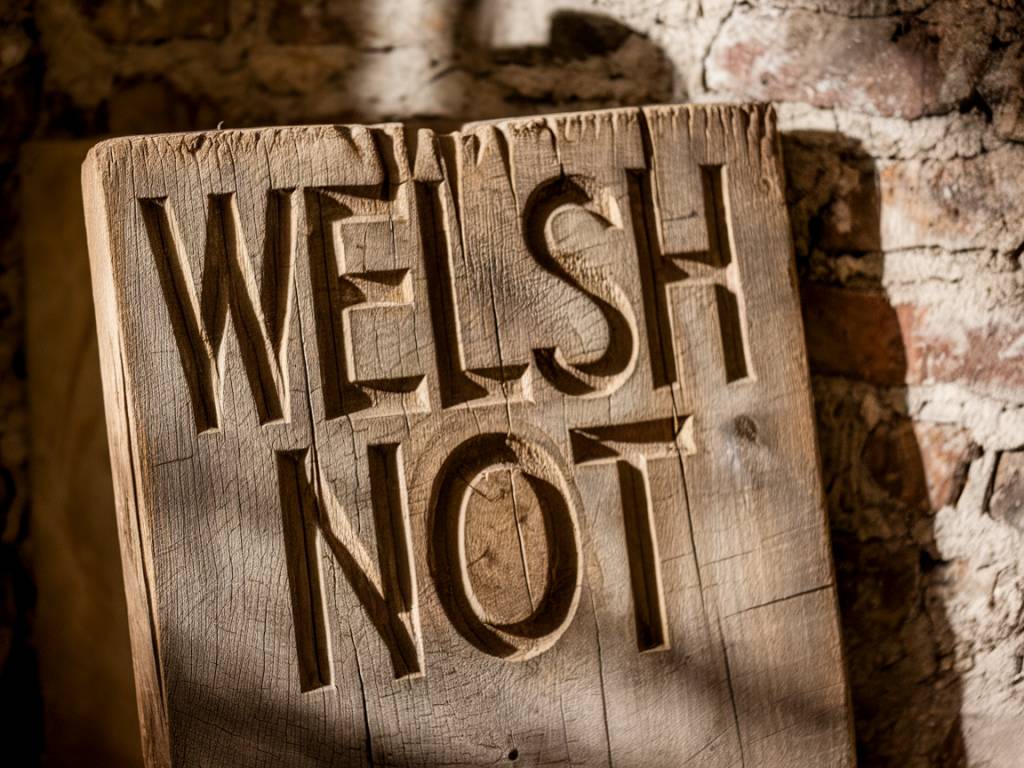What Was the Welsh Not?
Picture this: It’s the 19th century in Wales, a land rich with culture, history, and language. However, amidst the rolling green hills and close-knit communities, a quiet yet profound tragedy was brewing in Welsh schools. The culprit? A small wooden plaque inscribed with two deceptively simple words: « Welsh Not. »
The Welsh Not was a tool of discipline, but its implications ran much deeper than that. Used in schools during Britain’s push to standardize education across its nations, the Welsh Not was created to deter children from speaking their native tongue, Welsh, in favor of the English language. The shame associated with it left a mark—not just on the children forced to wear it, but on the cultural identity of Wales as a whole.
How Did It Work?
The Welsh Not was brutally straightforward. A child caught speaking Welsh at school would be forced to wear the wooden plaque around their neck. This stigmatizing marker wasn’t just a temporary punishment; it symbolized humiliation. Worse, the wearer would pass it on to the next child they overheard speaking Welsh, creating a ripple effect of blame and shame throughout the classroom.
At the end of the day, the student still wearing the Welsh Not would often face further punishment, such as physical reprimands or detention. This practice wasn’t just about enforcing discipline; it was about eradicating the Welsh language from future generations. The policy reflected a broader effort by authorities to promote English as the « superior » language, while Welsh was disdainfully dismissed as backward or unfit for « modern » society.
The Roots of Oppression
To truly grasp the tragic impact of the Welsh Not, it’s important to reflect on the social and political context of the time. During the 19th century, the British government was pushing for uniformity across its territories. Language, as a core part of cultural identity, became a battleground in this quest for control.
In 1847, the infamous « Blue Books » report—a government-commissioned study of Welsh education—characterized the Welsh language and culture as barriers to progress. The report even branded Welsh communities as lacking in ambition and morality, igniting a storm of outrage among Welsh speakers. The Welsh Not, already in sporadic use, gained traction as a tool to discourage the use of Welsh in schools. It was an indirect yet potent weapon in stripping away the linguistic heritage of a nation.
The Human Toll
So what was it like to grow up in this cultural crossfire? Imagine being an eight-year-old child, already nervous about school, and finding that speaking the language you’ve learned at home—your mother’s tongue—could lead to public humiliation. For many children, particularly those in rural areas where Welsh was the predominant language, the experience was traumatic.
Anecdotes from the time paint a haunting picture. Elders recount stories of their grandparents or great-grandparents who bore the Welsh Not as children, and the profound shame it instilled. Some even stopped speaking Welsh entirely, passing down their silence to the next generation. This ripple effect contributed to the decline of the Welsh language in the late 19th and early 20th centuries.
The Cultural Impact
While the Welsh Not may seem like a small, outdated relic of the past, its legacy is significant. It represents not just the repression of a language, but the systematic targeting of an entire cultural identity. For decades, many Welsh speakers felt pressured to abandon their native tongue to fit into an increasingly Anglicized society.
But here’s the twist: the Welsh people didn’t let their language disappear. Despite the efforts to suppress it, the Welsh language endured, thanks to the resilience of communities who recognized its intrinsic value. Today, Welsh is officially recognized as a minority language in the UK, and vibrant efforts are underway to preserve and promote it.
Signs of Hope
In modern Wales, the language has experienced a revival that would have been unthinkable in the era of the Welsh Not. Bilingual road signs, Welsh-language television networks like S4C, and popular cultural events such as the National Eisteddfod celebrate the nation’s linguistic heritage. Additionally, educational initiatives aim to make Welsh accessible to learners of all ages, ensuring that it remains a living, breathing part of everyday life.
It’s fascinating, isn’t it, how a community’s fierce love for its heritage can overturn even the most oppressive chapters of its history? Efforts to reclaim the Welsh language are a testament to the enduring strength of this culture—a spirit that refused to be broken by a mere wooden plaque.
Why It Matters Today
Reflecting on the history of the Welsh Not offers valuable lessons for the present. It’s a stark reminder of the dangers of cultural erasure and the need to protect minority languages as vital aspects of our shared human heritage. Language is more than a means of communication; it’s a vessel for stories, traditions, and a sense of belonging.
So, the next time you hear a Welsh speaker greet you with a cheerful “Shwmae,” take a moment to appreciate the journey that greeting represents. It’s not just a word—it’s a triumph, a subtle yet powerful act of cultural resilience that defied the odds.
A Legacy Worth Preserving
Though the story of the Welsh Not is a dark chapter in Wales’ history, it’s also a pivotal reminder of the importance of safeguarding cultural identity. The struggles faced by past generations have paved the way for a vibrant resurgence of pride in the Welsh language and traditions.
And perhaps that’s the true power of history: its ability to teach, to inspire, and to connect us to the stories that shaped the world we inhabit today. So let’s honor those who endured the Welsh Not by continuing to celebrate the language, culture, and spirit of Wales—past and present.

